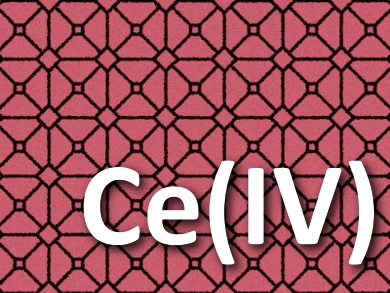Metal-organic frameworks (MOFs) are compounds with a wide variety of possible applications, e.g., as sensors, for gas separation, or in catalysis. Their properties can be tuned by changing either the metal ions or the organic linkers that make up the material. Cerium(IV), for example, has been used to create a number of very similar MOFs that could be useful for catalysis.
However, the development of further Ce(IV)-based MOFs has been hampered by the fact that Ce(IV) ions are strong oxidants and tend to be reduced during the MOF synthesis. The reactive character of Ce(IV) can also lead to the decomposition of the organic linkers.
Dirk E. De Vos, Katholieke Universiteit Leuven, Belgium, and colleagues have developed a method that allows the synthesis of new Ce(IV)-based MOFs by avoiding the use of simple, reactive Ce(IV) salts. The team instead used a Ce6 cluster as a precursor, namely [Ce6O4(OH)4(NH3CH2COO)8(NO3)4(H2O)6Cl8·8H2O]. This precursor is easy to synthesize. Aqueous solutions of the precursor were then combined with different linkers, e.g., 1,3,6,8-tetrakis(p-benzoate)pyrene (TBAPy4–) and tetrakis(p-carboxylatophenyl)porphyrin (H2TCPP4–).
The approach allowed the team to synthesize Ce(IV)-based MOFs that are not accessible from Ce(IV) salts. The method could also be used for the synthesis of previously known Ce(IV) MOFs, such as Ce-UiO-66, the cerium analogue of the well known MOF UiO-66. According to the researchers, these results could allow the further development of Ce(IV)-MOFs with potential uses in redox catalysis.
- A precursor method for the synthesis of new Ce(IV) MOFs with reactive tetracarboxylate linkers,
Simon Smolders, Arnaud Struyf, Helge Reinsch, Bart Bueken, Timo Rhauderwiek, Luise Mintrop, Philipp Kurz, Norbert Stock, Dirk E. De Vos,
Chem. Commun. 2018, 54, 876–879.
https://doi.org/10.1039/c7cc08200b



